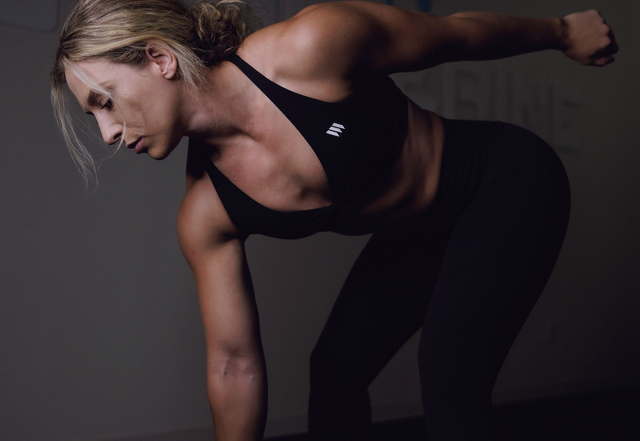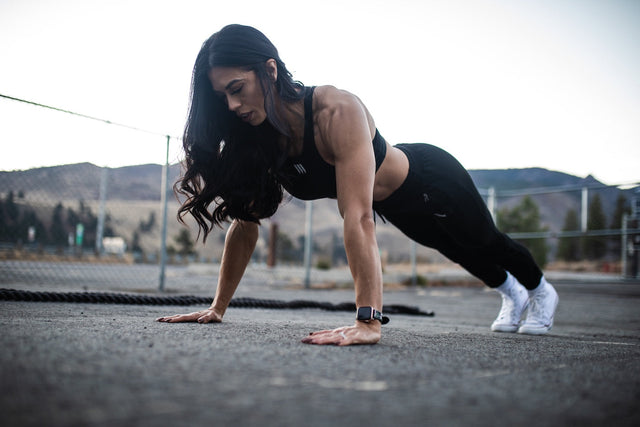Are you ready to sculpt those arms and show off your strength? Welcome to your ultimate guide on mastering the overhead tricep extension! This powerful exercise is a key player in toning and defining your triceps for those coveted sculpted arms.
Whether you're a fitness enthusiast looking to level up your arm workout or a newbie eager to enhance your overall strength, this comprehensive guide has got you covered. From the correct form to effective variations, we'll walk you through everything you need to know to maximize the benefits of the overhead tricep extension.
Get ready to say goodbye to flabby arms and hello to toned muscles that command attention. By incorporating this exercise into your routine, you'll be well on your way to achieving the strong and defined arms you've always wanted. So grab your weights, focus your mind, and let's master the overhead tricep extension together!
Understanding the Overhead Tricep Extension Exercise
The overhead tricep extension is a fundamental isolation exercise that focuses primarily on the triceps brachii, the muscle located on the back of your upper arms. This movement involves extending the arms overhead while holding a weight, which helps to isolate and strengthen the triceps. Due to its simplicity and effectiveness, it's a staple in most upper-body strength training programs.
To perform the overhead tricep extension, begin in either a standing or seated position, holding a dumbbell, barbell, or EZ curl bar with both hands above your head. Your elbows should stay tucked in close to your ears as you lower the weight behind your head, then extend your arms back to the starting position. This controlled motion not only emphasizes triceps development but also engages the shoulders and core, making it a compound movement that delivers multiple functional benefits.
Incorporating the overhead tricep extension into your workout routine can support both hypertrophy (muscle growth) and upper-body stability. Whether you're aiming to build mass or tone your arms, mastering this exercise can help you progress toward a more defined, functional, and stronger upper body.
Benefits of Incorporating Overhead Tricep Extensions into Your Workout Routine
1. Increased Strength
Overhead tricep extensions significantly enhance triceps strength, which plays a key role in pressing exercises and daily movements like pushing doors or lifting overhead. By strengthening this muscle group, you’ll also boost performance in compound lifts such as the bench press and overhead press, which rely heavily on triceps involvement. According to Schoenfeld (Journal of Strength and Conditioning Research), mechanical tension and muscle activation are critical for hypertrophy, making the overhead tricep extension an efficient choice for targeted triceps overload.
“The long head of the triceps is more effectively recruited during exercises involving shoulder flexion, such as overhead triceps extensions.” – Brad Schoenfeld, JSCR
2. Defines Your Arms
This exercise is an excellent tool for achieving toned, defined arms. It targets the long head of the triceps, which adds size and shape to the upper arm when developed. As you reduce body fat and maintain consistent training, you’ll begin to notice reduced arm flabbiness and greater muscle tone—especially in the area that often gets neglected in push-focused exercises.
Regularly performing overhead tricep extensions can also support metabolic efficiency, helping you burn more calories by maintaining lean mass, as explained in Liguori & Kraemer’s ACSM Guidelines for Exercise Testing and Prescription (ACSM, 2021).
3. Improves Joint Stability and Mobility
Overhead tricep extensions not only build strength but also improve shoulder mobility and elbow joint stability. Because the movement involves flexing and extending the arms overhead, it reinforces healthy range of motion and strengthens connective tissues. These benefits are crucial for longevity in training and injury prevention.
“Joint integrity and neuromuscular coordination improve with consistent resistance training, enhancing functional movement patterns.” – Jeffrey Potteiger, ACSM
Muscles Worked During the Overhead Tricep Extension
Triceps Brachii (Long, Lateral, and Medial Heads)
The primary muscle worked in the overhead tricep extension is the triceps brachii, which has three heads:
-
Long Head – most activated in overhead movements
-
Lateral Head – gives width to the upper arm
-
Medial Head – involved in elbow extension under all loads
Overhead positioning places the long head under a deeper stretch and higher tension compared to other triceps exercises, such as pushdowns or kickbacks. This makes it an essential move for full triceps development (Gentil et al., Sports Medicine).
Deltoids (Anterior)
The anterior deltoids assist during the lift, stabilizing the arms as the weight is held overhead. This shoulder involvement not only increases total muscle recruitment but also contributes to better postural support during the movement.
Core Muscles
Although it's an upper-body move, the core plays a stabilizing role, especially when performed standing. Engaging your transverse abdominis and lower back muscles helps prevent torso sway and ensures you maintain proper form throughout each repetition. This makes the exercise functional and effective beyond just arm aesthetics.
“Stability exercises that engage the core improve coordination and overall kinetic chain efficiency.” – Stuart McGill, Journal of Strength and Conditioning Research

Proper Form and Technique for the Overhead Tricep Extension
Achieving the correct form and technique is crucial when performing the overhead tricep extension to maximize muscle engagement and minimize injury risk. Start by choosing a moderate weight that allows you to maintain control throughout the movement. Whether you're seated or standing, position your feet shoulder-width apart and hold a dumbbell, barbell, or EZ curl bar with both hands overhead.
If you're using a dumbbell, grip it with both palms facing upward in a diamond grip. Begin the movement by inhaling and engaging your core muscles to maintain stability. Slowly bend your elbows to lower the weight behind your head, keeping your elbows close to your ears. Avoid flaring them outward—this can compromise form and place undue stress on the shoulder joint.
Lower the weight until you feel a controlled stretch in the triceps. Then, exhale as you extend your arms, pushing the weight back to the starting position and squeezing the triceps at the top. Keep your posture upright, avoid arching your lower back, and focus on keeping your elbows stationary. Practicing good form builds a strong foundation and increases the effectiveness of the exercise.
“Proper technique ensures maximum engagement of the long head of the triceps and reduces compensatory movement.” – Brad Schoenfeld, Journal of Strength and Conditioning Research
How to Perform the Overhead Triceps Extension (Step-by-Step Guide)
Step 1: Set Up
-
Stand or sit with a dumbbell, barbell, EZ bar, or cable rope attachment
-
Hold the weight with both hands, forming a diamond grip around the handle
-
Extend your arms fully overhead, with a slight bend at the elbows
Step 2: Lower the Weight
-
Bend your elbows to lower the weight behind your head
-
Keep your upper arms vertical and elbows close to your ears
-
Stop when you feel a deep stretch in your triceps (around 90–110 degrees)
Step 3: Extend and Squeeze
-
Push the weight back up to the starting position by extending your elbows
-
Squeeze the triceps at the top of the movement
-
Repeat for 8–12 reps, maintaining control throughout
Variations of the Overhead Tricep Extension for Different Fitness Levels
Adding variations keeps your training progressive and prevents plateaus. These overhead tricep extension modifications cater to every level:
Beginner:
-
Single-arm overhead tricep extension with a light dumbbell or resistance band
-
Great for focusing on unilateral strength and form correction
Intermediate:
-
Seated dumbbell or barbell overhead extensions for better core support
-
EZ curl bar overhead extensions for wrist comfort and heavier loads
Advanced:
-
Overhead cable tricep extensions for constant tension throughout the movement
-
Overhead tricep extension with wrist twist to stimulate all three triceps heads
-
Incline bench dumbbell extensions for added stretch and range of motion
“Altering resistance vectors and angles recruits muscle fibers differently, promoting balanced hypertrophy.” – Bret Contreras, T-Nation
Overhead Tricep Extension Equipment and Accessories
Common Equipment:
-
Dumbbells – most versatile, perfect for unilateral or bilateral training
-
EZ Bar – reduces wrist strain while allowing for heavier loads
-
Barbell – optimal for progressive overload and symmetrical grip
-
Cable Machine – delivers consistent resistance through full range of motion
Useful Accessories:
-
Flat or adjustable workout bench – stabilizes your base during seated variations
-
Stability ball – adds core activation when used as a bench substitute
-
Resistance bands – accessible option for beginners or warm-ups
“Selecting appropriate equipment can enhance neuromuscular activation and reduce injury risk.” – Liguori & Kraemer, ACSM Guidelines
Overhead Tricep Extension Workout Routine for Maximum Results
To make this exercise a cornerstone of your arm routine, structure your training with purposeful volume and intensity:
-
Beginners: 3 sets of 10–12 reps, light to moderate weight
-
Intermediate/Advanced: 4–5 sets of 8–10 reps, progressively increasing weight
-
Tempo: 2-second eccentric (lowering), 1-second pause, 1-second concentric (lifting)
Sample Superset Tricep Routine:
-
Overhead Tricep Extension – 4x10
-
Close-Grip Push-Ups – 3x12
-
Cable Rope Tricep Pushdowns – 3x15
Include a rest period of 60–90 seconds between sets and 2–3 tricep-focused sessions weekly. Always prioritize recovery and protein intake to support muscle repair.
Common Mistakes to Avoid During the Overhead Tricep Extension
Even small errors can hinder results or cause injury. Watch out for the following:
❌ Elbow Flaring
Letting your elbows move outward reduces tricep isolation and increases shoulder stress. Keep them locked in close to your head.
❌ Using Too Much Weight
Avoid sacrificing form just to lift heavier. Overloading leads to compensatory movement and increased risk of strain.
“Form breakdown during resistance exercise diminishes targeted muscle engagement and increases injury probability.” – Schoenfeld, Strength and Conditioning Journal
❌ Lack of Core Engagement
Failing to brace your core can result in excessive back arching, reducing stability. Keep your abs tight and spine neutral.
Overhead Tricep Extension Progress Tracking and Measurement
Ways to Track Progress:
-
Workout Log: Record weights, sets, reps, rest time, and rate of perceived exertion (RPE)
-
Progress Photos: Take biweekly photos to visually track arm development
-
Strength Goals: Set targets (e.g., increase by 5 lbs every 2 weeks)
Tracking these metrics helps maintain motivation and ensures you're progressing consistently.
“Goal setting and tracking are proven behavioral strategies that reinforce consistency in resistance training.” – ACSM, 2021 Guidelines
Conclusion: Unlock Stronger, More Sculpted Arms with Every Rep
The overhead tricep extension isn't just another arm exercise—it's a powerhouse move that delivers serious results when done right. Whether you're aiming to carve out lean, defined arms or build pressing strength for your bigger lifts, this exercise deserves a top spot in your routine.
By mastering proper form, exploring challenging variations, and tracking your progress, you’ll unlock more than just aesthetic gains—you’ll develop functional strength, improve joint stability, and build the confidence that comes from knowing your body is stronger, more capable, and primed for performance.
So next time you hit the gym, grab those dumbbells, engage your core, and own every rep. Your triceps—and your future self—will thank you.
Find similar articles:
Fitness






